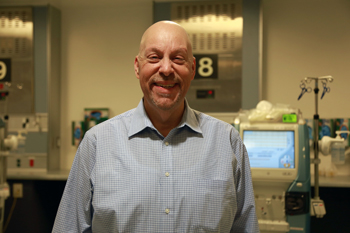‘After my transplant, I had time’: A patient’s kidney transplant journey

By Ana Gajic

John DiLallo
John DiLallo woke up one day with pain in his leg.
Having experienced a similar ache in the past, he stopped at the St. Joseph’s Health Centre Emergency Department on his way to work, expecting it would be a quick check-up.
To his surprise, routine blood work revealed an issue unrelated to the pain: DiLallo had late-stage kidney disease and would need to go on dialysis to prepare him for a transplant down the road.
“I was bewildered,” he said. “It felt like a death sentence because it was so unknown.”
A bridge to transplant
Dialysis is a treatment for kidney disease by which waste products and excess fluid are removed from the body. In hemodialysis, a patient’s blood enters a machine that acts as an artificial kidney; the blood is cleaned and then returned to the body. An alternate form is peritoneal dialysis, in which the patient’s abdominal membrane is used as a filter to remove toxins.
“Dialysis is not a replacement for native kidney function,” said Dr. Joanna Sasal, head of nephrology at St. Joseph’s. “It is a bridge and just one stop in a patient’s journey to transplant if they are eligible for kidney transplantation.”
DiLallo was placed on the transplant list to receive a kidney transplant at St. Micheal’s Hospital and opted for hemodialysis at St. Joseph’s. He made a commitment to never miss a single dialysis treatment – even if it meant scheduling appointments at clinics across Canada and the United States when he travelled. As his BMI was too high to be a candidate for transplant at his initial diagnosis, he also put himself on a strict exercise and weight loss regiment.
“I needed to help the health team help me,” he said. “When I look back over all the years on dialysis, I was so focused on moving forward that I didn’t have time to look back. Every conversation with my doctors was about getting to the next step. It was a strategy.”
The call
DiLallo spent seven and a half years on dialysis. He went through various procedures, both to regulate his weight and manage other health issues that had come up. In 2016, DiLallo’s urology team at St. Michael’s determined he was physically fit for transplant. The call could come at any time.
“Some days I thought it would never happen,” DiLallo recalled.
Over the holidays in 2016, DiLallo was about to have lunch with his wife when his phone rang. It was St. Michael’s, and they had a kidney from a deceased donor that looked like it would be a match.
In the most recent reporting year available, St. Michael’s transplanted 97 kidneys, the second highest amount transplanted in Ontario. As one of the largest adult kidney transplant programs in Canada, the team cares for about 1,700 patients who have had kidney transplants. The nephrology, urology and transplant teams at St. Michael’s had been working with DiLallo towards this day from the beginning of his journey.
“After my transplant, I felt like I had woken up,” DiLallo said. “I walked back into my life after being asleep for more than seven years.
“Who do I have to thank for all of this? My wife, St. Joe’s and St. Mike’s. I’m just a player on the team and I had great teammates. My doctors, my nurses, and my technicians: they’re all my teammates and we scored.”
Slowly, DiLallo’s body normalized after transplant. He had more energy, and because he didn’t have to plan out dialysis treatments, DiLallo had time.
Giving back
Early on in his treatment at St. Joseph’s, DiLallo promised the health-care team that he would find a way to give back to the hospitals that had helped him. Now, he’s a patient and family advisor at St. Michael’s and becoming one at St. Joseph’s. He’s going to be one of the first ambassadors in the Transplant Ambassador Program at St. Joseph’s and hopes to talk to patients like him who may be considering transplant as an option.
“There’s very little happening to people that hasn’t happened to me,” DiLallo said. “It was not easy but now I can relate to people. I’ve been in the chair many times and I know it can be painful. If I can carry the load for someone, even for a few minutes, then I’ve helped.”
For patients in dialysis, Dr. Sasal said that information from a peer can change patients’ lives.
“John can share his journey from the platform of a person who has lived it,” she said. “We are very grateful for his support.”
DiLallo’s work may also help raise awareness of the opportunity to be a donor to someone in need.
“The person who registered to be an organ donor and blessed me with a new kidney is now part of my life forever,” he said.
“They’re always with me. If you want to be remembered forever, register to be an organ and tissue donor. If you want to be loved forever, register to be an organ and tissue donor. It takes a special person to register to be an organ donor and give such a generous gift.”
About St. Michael’s Hospital
St. Michael’s Hospital provides compassionate care to all who enter its doors. The hospital also provides outstanding medical education to future health care professionals in more than 29 academic disciplines. Critical care and trauma, heart disease, neurosurgery, diabetes, cancer care, care of the homeless and global health are among the Hospital’s recognized areas of expertise. Through the Keenan Research Centre and the Li Ka Shing International Healthcare Education Centre, which make up the Li Ka Shing Knowledge Institute, research and education at St. Michael’s Hospital are recognized and make an impact around the world. Founded in 1892, the hospital is fully affiliated with the University of Toronto.
